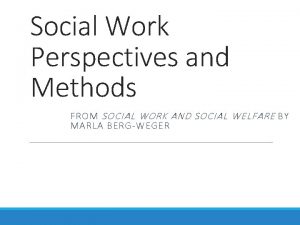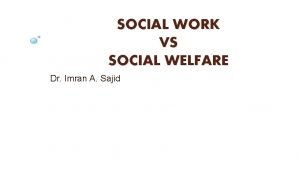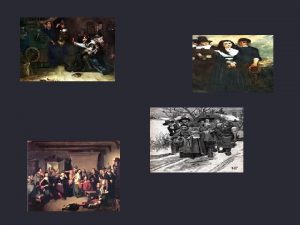Research in Social Work Practice Salem State University



























- Slides: 27

Research in Social Work Practice Salem State University School of Social Work Class 6 Jeff Driskell, MSW, Ph. D

2 Class Agenda • Check-in/Announcements • Review ▫ Think…Pair…Share • Lecture▫ Theory in Research ▫ Quantitative approaches to research ▫ Internal/external validity

Elements of Quantitative Design • Variables ▫ IV and DV • Relationships and comparisons ▫ Correlation ▫ comparisons • Theory Driven • Testable Hypotheses ▫ Directional or nondirectional • Methodology ▫ Sampling ▫ Data collection • Design structure • Cross-sectional, longitudinal • Experimental, quasi • Statistical analyses

Quantitative Research Goal: An attempt to determine if there is a relationship between identified variables. ▫ Correlation ( a link between two or more variables) ▫ Comparison (comparing groups on a particular variable(s) ▫ Causal (one variable causing change in another)

Criteria for Inferring Causality 1) Cause (IV) must precede the effect (DV) in time (temporal order) 2) The two variables are empirically correlated with one another (statistically determined) 3) The correlation between the two variables can not be due to the influence of a third variable

Quantitative Research Design

Quantitative Research Design ▫ Experimental True randomized trial Experimental and control group Establishes cause and effect Most common- pre-test/post-test design ▫ Quasi-experimental Comparison/control group- may not be comparable due to a lack of random assignment ▫ Non-experimental designs (Pre) No cause and effect Looks at relationships and comparisons

Breaking it Down… • Non-experimental (pre-experimental) ▫ One-group post test only design ▫ One-group pre/post test design • Quasi-experimental ▫ Time series design (no comparison group) ▫ Time series design with comparison group ▫ Post-test only with non-equivalent group design • Experimental ▫ Pre-test/post test control group design

Mapping research designs …not tic-tac-toe… • R = Randomization • O = Observation (survey, quiz) • X = Intervention/Stimulus (counseling, lecture) • ------ = more than one group in study

Experimental Designs § Experimental designs are the strongest designs allowing social work researchers and evidence-based practitioners to have increased confidence in making causal inferences based of study findings

Random Assignment § Controls for selection bias in experimental designs § Participants are divided into groups using procedures based on probability theory § Improves the likelihood that the control group represents what the experimental group would look like had it not been exposed to the experimental stimulus

Diagram of a Basic Experimental Design R R O 1 X O 2 © 2011, Brooks/ Cole Publishing, A Division of Cengage Learning, Inc.

Decision Tree

Example- Project Enhance

Research Design Application

Research design 101 • Cross-sectional • 01 • Example: – Caregiver views on a support group for parents with children in DSS custody

Research design 101 • Multistage crosssectional, panels of different people • 01 -01 -01 -01

Research design 101 • Pre/post test: • 01 -X 1 -02 • Example: – Evaluation of a treatment compliance intervention

Research design 101 • Post-test only • X 1 -01 • Example: – Policy analysis of employment among single mothers after leaving TANF

Research design 101 • Time series, longitudinal • 01 -X 1 -02 -X 2 -03 -X 3 -04 • Evaluation of longterm psychotherapeutic treatment with same group over time

One-Shot Case Study X 0 Fails to control for any threats to internal validity

One Group Pretest-posttest Design 01 X O 2

Quasi-experimental Designs § Designs that are distinguished from true experiments primarily by the lack of random assignment of subjects § Useful when it is not feasible to obtain a control group § Three common quasi-experimental designs : − Nonequivalent comparison group designs − Simple time-series designs − Multiple time-series designs

Nonequivalent Comparison Groups Designs § Two existing groups that appear to be similar are identified or created (homogenous) § The dependent variable is assessed before and after an intervention is introduced to one of the groups § Comparison group (not to be confused with control group) does not receive the intervention O 1 X O 2

Simple Time-Series Designs § A simple interrupted time-series design attempts to develop causal inferences based on a comparison of trends over multiple measurements before and after an intervention is introduced and requires no comparison group O 1 O 2 O 3 O 4 O 5 X O 6 O 7 O 8 O 9 O 10 § The more measurements, the stronger the design

Multiple Time-Series Designs § Both an experimental group and a comparison group are measured at multiple points in time before and after an intervention is introduced to the experimental group O 1 O 2 O 3 O 4 O 5 X O 6 O 7 O 8 O 9 O 10 O 1 O 2 O 3 O 4 O 5 O 6 O 7 O 8 O 9 O 10

Exercise- Putting it all together • Locate 2 quantitative based research articles • Answer the following question: ▫ ▫ ▫ Identify the research question(s) What are the IV and DV’s? Identify hypotheses Identify type of design Map out the research design (R, O, X). Internal and external validity. What are the concerns for both types of validity (think about the terms you just learned about)?
 Salem state university school of social work
Salem state university school of social work San jose state social work
San jose state social work Salem state msw
Salem state msw Salem state career services
Salem state career services Wsfcs social studies
Wsfcs social studies Novosibirsk national research state university
Novosibirsk national research state university Generalist intervention model
Generalist intervention model Elements of social case work
Elements of social case work Theories for direct social work practice
Theories for direct social work practice The weather model of reflection
The weather model of reflection Define policy practice
Define policy practice Berg-weger practice of generalist social work download
Berg-weger practice of generalist social work download Wmu school of social work
Wmu school of social work Boston university social work
Boston university social work Professional boundaries in social work quiz
Professional boundaries in social work quiz University of texas arlington social work
University of texas arlington social work Boston university school of social work
Boston university school of social work University of memphis school of social work
University of memphis school of social work Griffith social work
Griffith social work Remedial social work
Remedial social work Social welfare vs social work
Social welfare vs social work Principle of dramatization
Principle of dramatization Social work and other social sciences
Social work and other social sciences Global agenda for social work and social development
Global agenda for social work and social development Social change in social work
Social change in social work Social thinking and social influence in psychology
Social thinking and social influence in psychology Social thinking social influence social relations
Social thinking social influence social relations Salem witch trials discovery education
Salem witch trials discovery education


















































